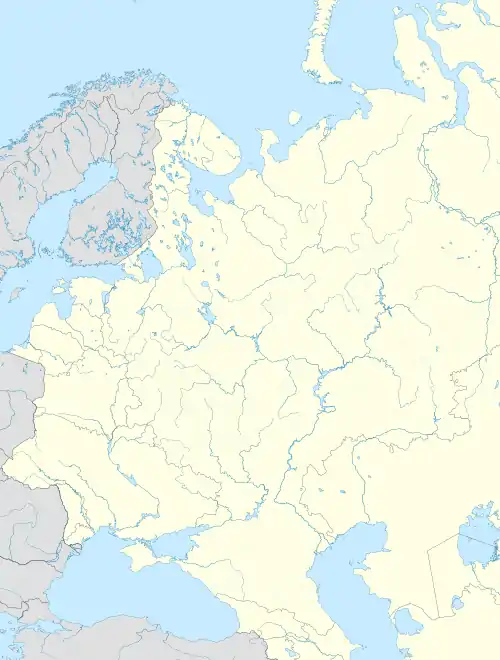
.jpg.webp)
The Arkhangelsk–Astrakhan line,[nb 1] or A–A line for short, was the military goal of Operation Barbarossa. It is also known as the Volga–Arkhangelsk line,[1] as well as (more rarely) the Volga–Arkhangelsk–Astrakhan line.[nb 2][2] It was first mentioned on 18 December 1940 in Führer Directive 21 (Fall Barbarossa) which enunciated the set goals and conditions of the German invasion of the Soviet Union, describing the attainment of the "general line Volga–Archangelsk" as its overall military objective.[3]
Background
The line had its origins in an earlier military study carried out in the summer of 1940 by Erich Marcks called the Operation Draft East.[4] This report advocated the occupation of Russia up to the line "Arkhangelsk-Gorky-Rostov" in order to prevent it from being a threat to Germany in the future and "protect it against enemy bombers". Marcks envisioned that the campaign, including the capture of Moscow and beyond, would require between nine and seventeen weeks to complete.[4]
The hypothetical A-A line was to stretch from the port city of Arkhangelsk on the White Sea in northern Russia along the confluence of the Volga river to the port city of Astrakhan at the mouth of the Volga on the Caspian Sea. Germany's invasion of the Soviet Union failed to secure any of these objectives.
Goals
The plan was for the Red Army to the west of the line to be defeated in a quick military campaign in 1941 before the onset of winter.[5] The German Wehrmacht assumed that the majority of the Soviet military supplies and the main part of the food and population potential of the Soviet Union existed in the lands that lay to the west of the proposed A-A line.[5] If the line were reached, the Soviet Union would also be deprived of around 86% of its petroleum assets (oil territories in the Caucasus).
The A-A line as the end-goal of military hostilities was chosen because an occupation of the entire Soviet Union in a single military campaign was considered impossible in view of its geographic dimensions. The remaining Soviet industrial centers further eastward were planned to be destroyed by aerial bombardment, for which an entire Luftflotte ("air fleet"; equivalent in status to an army group) was to be assigned.[5]
See also
Notes
References
- ↑ Boog, Horst (1996). Germany and the Second World War: The attack on the Soviet Union, p. 278. Oxford University Press Inc., New York.
- ↑ Boog, p. 803.
- ↑
 Works related to Führer Directive 21 at Wikisource.
Works related to Führer Directive 21 at Wikisource. - 1 2 Kay, Alex J. (2006). Exploitation, Resettlement, Mass Murder: Political and Economic Planning for German Occupation Policy in the Soviet Union, 1940-1941", p. 31. Berghahn Books.
- 1 2 3 Rich, Norman (1973). Hitler's War Aims: Ideology, the Nazi State, and the Course of Expansion, pp. 210-212. W. W. Norton & Company Inc., New York.